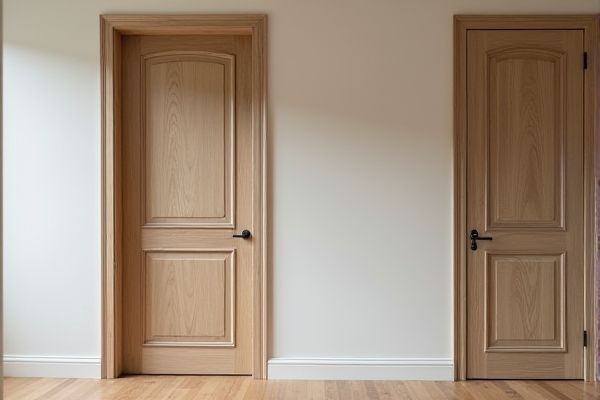
Pocket doors save space by sliding neatly into the wall, making them ideal for compact areas, while hinged doors offer a traditional swing that can enhance accessibility and style. Explore the detailed comparison to determine which door type best suits your study entry and meets Your spatial and aesthetic needs.
Table of Comparison
| Feature | Pocket Door | Hinged Door |
|---|---|---|
| Space Efficiency | Slides into wall cavity, saving floor space | Requires clear swing area; occupies floor space |
| Installation Complexity | Requires wall modification and precise track alignment | Simple installation; standard door frame and hinges |
| Cost | Higher cost due to hardware and wall adjustments | Lower cost; widely available standard hardware |
| Maintenance | Track and rollers need regular maintenance | Minimal; hinges may require occasional lubrication |
| Accessibility | Easier for wheelchair access; no door swing obstruction | Potential obstruction if door swings inward/outward |
| Aesthetic | Modern, seamless look; door hidden when open | Traditional look; door visible when open or closed |
| Noise Reduction | Less effective due to gaps and wall cavity | Better acoustic seal when closed |
Introduction to Pocket Doors and Hinged Doors
Pocket doors slide into a wall cavity, saving space and offering a sleek, modern look ideal for compact study entries. Hinged doors swing open on a hinge, providing a traditional aesthetic with a reliable seal and straightforward installation. Both door types influence room layout, lighting, and accessibility in study entryways, affecting furniture arrangement and traffic flow.
Space Efficiency in Study Entryways
Pocket doors offer superior space efficiency in study entryways by sliding seamlessly into the wall cavity, eliminating the need for swing clearance and maximizing usable floor area. Hinged doors require clear space for opening and closing, which can restrict furniture placement and reduce accessibility in compact study entries. When optimizing your study's layout, choosing a pocket door enhances spatial flow and allows for more flexible interior design options.
Installation Process: Pocket vs Hinged Doors
Pocket door installation requires creating a cavity within the wall frame to house the door, involving more complex carpentry and potential modifications to wall studs. Hinged doors are simpler to install, attaching directly to existing door jambs with standard hinges and minimal wall alteration. Your choice impacts labor costs and structural adjustments, making pocket doors more suited for space-saving solutions while hinged doors offer straightforward installation.
Aesthetic Appeal and Design Flexibility
Pocket doors offer superior aesthetic appeal by creating a clean, uncluttered look that seamlessly blends into walls, maximizing space and enhancing modern design flexibility. Hinged doors provide traditional charm with a variety of styles and finishes but require clear swing space, limiting room layout options. Your choice depends on whether you prioritize sleek, space-saving elegance or classic, versatile design elements.
Accessibility and Ease of Use
Pocket doors offer enhanced accessibility by sliding into the wall, saving floor space and allowing wider openings for easy movement, especially beneficial for wheelchair users. Hinged doors require clear floor space to swing open, which can limit accessibility and maneuverability in smaller entryways. Your choice should consider the mobility needs and spatial constraints to ensure maximum ease of use.
Durability and Maintenance Requirements
Pocket doors offer enhanced durability in spaces with limited room as their sliding mechanism reduces wear and tear on hinges compared to hinged doors, which often experience stress from frequent opening and closing. Maintenance for pocket doors can be more complex due to the concealed track system that may accumulate debris, requiring periodic cleaning and lubrication, whereas hinged doors typically need straightforward hinge tightening and occasional repainting or refinishing. Your choice should consider long-term upkeep, as pocket doors demand technical maintenance while hinged doors offer simpler, more accessible repairs.
Privacy and Sound Insulation
Pocket doors typically offer less privacy and sound insulation compared to hinged doors due to their sliding mechanism and wall cavity installation, which can allow sound to travel through more easily. Hinged doors provide a tighter seal around the frame, enhancing acoustic isolation and preventing sound leakage between rooms. For study entry rooms requiring quiet and minimal disturbance, hinged doors are generally more effective in maintaining privacy and reducing noise transmission.
Cost Comparison: Pocket Door vs Hinged Door
Pocket doors generally incur higher installation costs than hinged doors due to the need for wall modifications and specialized hardware, with prices ranging from $500 to $1,500 compared to $150 to $500 for hinged doors. Hinged doors offer more affordable repair and maintenance expenses because of their simpler design and easier access for adjustments. For budget-conscious projects, hinged doors provide cost-efficiency, while pocket doors represent a higher upfront investment influenced by labor and material complexities.
Suitability for Different Study Layouts
Pocket doors excel in small or narrow study layouts by saving floor space and allowing flexible furniture arrangement, enhancing room functionality. Hinged doors suit larger studies with ample clearance, offering a traditional aesthetic and easier installation. Your choice depends on maximizing space efficiency or prioritizing classic design in your study area.
Conclusion: Choosing the Best Door for Your Study Entry
Pocket doors save valuable floor space, making them ideal for small study entries where maximizing room functionality is critical. Hinged doors offer better sound insulation and a traditional aesthetic, suitable for studies requiring privacy and noise control. Assessing spatial constraints, desired privacy level, and design preferences helps determine the best door type for your study entry.
 homyna.com
homyna.com